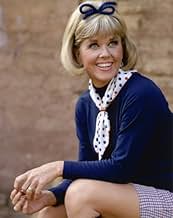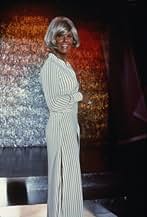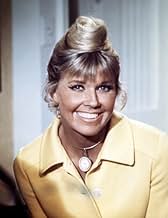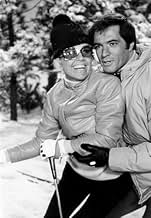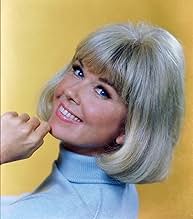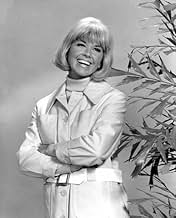Aggiungi una trama nella tua linguaAfter spending most of her life in big cities, widow Doris Martin decides to move back to the family ranch.After spending most of her life in big cities, widow Doris Martin decides to move back to the family ranch.After spending most of her life in big cities, widow Doris Martin decides to move back to the family ranch.
- Premi
- 2 candidature totali
Sfoglia gli episodi
Recensioni in evidenza
This show ran from 1968 until 1973, and I hadn't seen it on TV probably since its initial run until the DVDs came out. The show aired at a time when American culture was going through a great transition. When Doris Day first went on the air Bonanza and The Andy Griffith Show were the top television draws. By the time it went off the air it was All in the Family and M.A.S.H. Thus it is amazing that Doris Day stayed on the air for five years during this time when her clean-cut image probably set her apart from the crowd, and then walked away from her show - the show was not canceled due to poor ratings. In fact, it did quite well throughout its run.
It will take you back to a simpler time, but then so did Doris Day's films and I still find those enjoyable. The show did make major changes to accommodate the changing times. Initially it had a rural setting with Doris being a widow with two sons who played a major part in the show. First the show had her moving to San Francisco. Next she and her sons moved to a more "hip" apartment. By season four the kids and her widowhood status had disappeared and she was single. Her father and her sons just vanished into thin air, never to be mentioned again.
Also, Doris evolved from a secretary to an associate editor. However, she kept her name and the second apartment she had when her sons had existed. It was very confusing. I'd still recommend it, just remember that culture changed so fast in the U.S. during this time that it even had an effect on how Doris Day was presented.
It will take you back to a simpler time, but then so did Doris Day's films and I still find those enjoyable. The show did make major changes to accommodate the changing times. Initially it had a rural setting with Doris being a widow with two sons who played a major part in the show. First the show had her moving to San Francisco. Next she and her sons moved to a more "hip" apartment. By season four the kids and her widowhood status had disappeared and she was single. Her father and her sons just vanished into thin air, never to be mentioned again.
Also, Doris evolved from a secretary to an associate editor. However, she kept her name and the second apartment she had when her sons had existed. It was very confusing. I'd still recommend it, just remember that culture changed so fast in the U.S. during this time that it even had an effect on how Doris Day was presented.
You all know the backdrop of this series so I won't bore you with it. I love this show and I too like the season 2 and 3 shows the best. As far as format changes go, I think they did a really good job going from season 1 to 2 to 3. It was a logical progression, Doris gets a job, then she moves the family into town etc. I hate the way they changed the format in season 4 and 5. Had I been around at that time to put my two cents in I would have done several things. 1. In season 4 I would have left things exactly as they were in season three and brought in the Peter Lawford character as Doris's serious love interest and possible step father for the boys. This along with the normal goings on would have brought yet another logical advancement. 2. In season 5 I would have Doris and Peter get engaged, Doris gets a new Boss and is promoted to a staff writer position at the magazine. The season finale would have been Doris and Peter's wedding with the entire cast from all the seasons in attendance. This could have been a huge ratings getter and a great way to end the series. I just don't know what they were thinking when they did 4 and 5. There are some episodes that are good but the show is missing the heart it had in 1,2, and 3. As was stated by another poster we cant go back and change history but thankfully there is enough good in seasons 1 2 and 3 that I watch them all the time. A must for Doris Fans.
I didn't watch much of the Doris Day Show when it was on, I hated the idea that America's top female movie star was forced to do TV. Because I'm a Doris Day collector, I purchased THE DORIS DAY SHOW First Season.
Now, I remember. I saw the first couple of shows and quit watching. Now watching the later shows from the first season, I can't believe how good this is! Leave it to Doris Day to make a silk purse out of a sow's ear. Her acting is incredible -- she doesn't miss a trick. As Jack Lemmon said about Day, "It was elevating to act with her." AND THAT BODY! Doris Day had the best figure in Hollywood. Don't get me wrong, I thought that Marilyn Monroe was voluptuous, but Doris' figure was perfect. She could wear anything and look terrific.
I'm looking forward to the rest of the seasons. On this collection, there are some fun extras, including Doris' two appearances on the TV classic, What's My Line?"
Looking back, Doris Day was robbed. She never got nominated as Best Actress in a comedy by the Emmys. Clearly, she was better than Lucille Ball in the messy and overplayed, "Here's Lucy" and as good or better than the actresses that WERE being nominated during this period. But I must point out, this series was done during the "I hate Doris Day" period in the USA. Everybody frowned on Day as being "too clean" and "a virgin." Of course all of that was nonsense and looks silly today, but that was the atmosphere in which Doris filmed this series.
The Emmys often ignored the best. Remember, the marvelous Esther Rolle was never nominated for her formidable work on "Good Times."
Now, I remember. I saw the first couple of shows and quit watching. Now watching the later shows from the first season, I can't believe how good this is! Leave it to Doris Day to make a silk purse out of a sow's ear. Her acting is incredible -- she doesn't miss a trick. As Jack Lemmon said about Day, "It was elevating to act with her." AND THAT BODY! Doris Day had the best figure in Hollywood. Don't get me wrong, I thought that Marilyn Monroe was voluptuous, but Doris' figure was perfect. She could wear anything and look terrific.
I'm looking forward to the rest of the seasons. On this collection, there are some fun extras, including Doris' two appearances on the TV classic, What's My Line?"
Looking back, Doris Day was robbed. She never got nominated as Best Actress in a comedy by the Emmys. Clearly, she was better than Lucille Ball in the messy and overplayed, "Here's Lucy" and as good or better than the actresses that WERE being nominated during this period. But I must point out, this series was done during the "I hate Doris Day" period in the USA. Everybody frowned on Day as being "too clean" and "a virgin." Of course all of that was nonsense and looks silly today, but that was the atmosphere in which Doris filmed this series.
The Emmys often ignored the best. Remember, the marvelous Esther Rolle was never nominated for her formidable work on "Good Times."
THE DORIS DAY SHOW (CBS, 1968-73), stars Doris Day in her only weekly comedy series. An actress whose screen career lasted twenty years (1948-1968), ranging from musicals, comedies and heavy dramas, at this point. By 1968, her career was virtually over, until finding herself working for the little screen called television.
THE DORIS DAY SHOW, premiering on CBS in September of 1968, opens with her signature theme song, "Que Sera Sera." The first season finds the widowed Doris Martin (Doris Day), living with her white haired, bearded father, Buck Webb (Denver Pyle) on the family ranch with her two blond-haired sons, Billy (Philip Brown) and Toby (Todd Starke), the little guy with a buck tooth. With similarities to the recent TV show, GREEN ACRES, Doris is a city girl now back on the farm. Supporting her father is the hired hand country boy, LeRoy B. Simpson (James Hampton). There's also a housekeeper, Aggie (Fran Ryan), and later Juanita (Naomi Stevens). The first season followed the tradition of other sit-coms of that time, sugar sweetness with country humor, never rising above the number one TV show of that time, THE ANDY GRIFFITH SHOW. The second season found Doris Martin still living on the farm, but now commuting to San Francisco and working as a secretary for Mr. Nicholson (MacLean Stevenson) at TODAY'S WORLD MAGAZINE. Also in support is Myrna Gibbons (Rose Marie, best known as Sally Rogers in THE DICK VAN DYKE SHOW). Rose Marie became an added plus in the show, although her character, a single woman always looking for the Mr. Right, was actually no different from her role on Van Dyke's show. Myrna and Doris were given a second banana character in the carnation of Ron Harvey (Paul Smith), a bachelor co-worker on the trail of beautiful female companionship. With this change, the show was slowly finding itself. For season three, Doris moves from her father's farm, taking her the boys and their sheepdog, Lord Nelson, to an apartment in San Francisco over an Italian restaurant run by Angie and Louie Palucci (Kaye Ballard and Bernie Kopell). Doris continues to work at TODAY'S WORLD MAGAZINE. Denver Pyle, no longer a series regular, appeared occasionally mostly in guest spots. While still working woman, Doris manages to find quality time with her boys. Up to this time, THE DORIS DAY SHOW improved, showing both humor and heart to the character and plots, but it was still trying to find itself.
As a youngster growing up during this period, I always enjoyed programs like this, especially whenever they included kids. The big change came with seasons four and five when Mrs. Doris Martin, still working at TODAY'S WORLD MAGAZINE and living in the same apartment on top of Palucci's Italian Restaurant, becomes Miss Doris Martin, a bachelor girl. The format shifted gears, eliminating the Martin boys, their dog, and contradicting everything from the previous seasons. Regardless, the show finally found itself. Of course there were occasional characters reprising their roles from the previous seasons, namely Kaye Ballard, Van Johnson and Billy DeWolfe (hilarious as Mr. Jarvis), so obviously this is the same character and same show with different format. Another difference, being true to life, is Doris now working as a staff writer for a new boss, Cy Bennett (the mustached John Dehner), supported by new co-worker pal, Jackie (Jackie Joseph). Changing her employer from a handsome and easy-going man to a stuffy middle-aged miser was a fine change, which found Doris at wits with her stingy boss. The final two seasons is the format that lasted the longest.
This new format would have worked had Doris Martin remained what she has been previously. Having the boys mentioned as being sent away to boarding school would have explained the emptiness of her apartment. It's surprising it wasn't renamed THE NEW DORIS DAY SHOW. What did happen was Doris Day succeeded in making this dramatic change work. For most, the working girl/family episodes from the second and third seasons are the best. The worst episodes are those with Doris as the only model in the annual fashion shows. A musical show showcasing Doris's fine singing voice would have been preferable, almost as nostalgic as the two Christmas episodes (1970 and 1971) which made them so enjoyable. One episode I remember most but like the least is "Young Love" from Season Three, where Doris appears in the opening segment, comforting a troubled teen named April (played by Meredith Baxter), who tells her story via flashback, taking up the entire episode. In Seasons Four and Five, Doris Martin found a romantic love interest, a middle-aged doctor, played by silver-haired Peter Lawford.
An episode, which I feel might be the one closest to Doris Day's heart, is the one in which she goes on trial for releasing a group of dogs locked in an automobile parked in the hot sun with shut windows. After being taken to court by the owner, she, of course, gets acquitted following her plea in the courtroom for the safety of dogs and other creatures, and her willingness to do what she did again even if it meant serving jail time. No doubt this could be Doris Day's personal favorite since it's more Doris Martin being Doris Day, an animal rights activist.
All episodes of THE DORIS DAY SHOW were produced on film and in color. Interestingly, seldom revived in syndication. Unseen on cable since the 1980s, all 128 episodes are currently available on DVD.
THE DORIS DAY SHOW, premiering on CBS in September of 1968, opens with her signature theme song, "Que Sera Sera." The first season finds the widowed Doris Martin (Doris Day), living with her white haired, bearded father, Buck Webb (Denver Pyle) on the family ranch with her two blond-haired sons, Billy (Philip Brown) and Toby (Todd Starke), the little guy with a buck tooth. With similarities to the recent TV show, GREEN ACRES, Doris is a city girl now back on the farm. Supporting her father is the hired hand country boy, LeRoy B. Simpson (James Hampton). There's also a housekeeper, Aggie (Fran Ryan), and later Juanita (Naomi Stevens). The first season followed the tradition of other sit-coms of that time, sugar sweetness with country humor, never rising above the number one TV show of that time, THE ANDY GRIFFITH SHOW. The second season found Doris Martin still living on the farm, but now commuting to San Francisco and working as a secretary for Mr. Nicholson (MacLean Stevenson) at TODAY'S WORLD MAGAZINE. Also in support is Myrna Gibbons (Rose Marie, best known as Sally Rogers in THE DICK VAN DYKE SHOW). Rose Marie became an added plus in the show, although her character, a single woman always looking for the Mr. Right, was actually no different from her role on Van Dyke's show. Myrna and Doris were given a second banana character in the carnation of Ron Harvey (Paul Smith), a bachelor co-worker on the trail of beautiful female companionship. With this change, the show was slowly finding itself. For season three, Doris moves from her father's farm, taking her the boys and their sheepdog, Lord Nelson, to an apartment in San Francisco over an Italian restaurant run by Angie and Louie Palucci (Kaye Ballard and Bernie Kopell). Doris continues to work at TODAY'S WORLD MAGAZINE. Denver Pyle, no longer a series regular, appeared occasionally mostly in guest spots. While still working woman, Doris manages to find quality time with her boys. Up to this time, THE DORIS DAY SHOW improved, showing both humor and heart to the character and plots, but it was still trying to find itself.
As a youngster growing up during this period, I always enjoyed programs like this, especially whenever they included kids. The big change came with seasons four and five when Mrs. Doris Martin, still working at TODAY'S WORLD MAGAZINE and living in the same apartment on top of Palucci's Italian Restaurant, becomes Miss Doris Martin, a bachelor girl. The format shifted gears, eliminating the Martin boys, their dog, and contradicting everything from the previous seasons. Regardless, the show finally found itself. Of course there were occasional characters reprising their roles from the previous seasons, namely Kaye Ballard, Van Johnson and Billy DeWolfe (hilarious as Mr. Jarvis), so obviously this is the same character and same show with different format. Another difference, being true to life, is Doris now working as a staff writer for a new boss, Cy Bennett (the mustached John Dehner), supported by new co-worker pal, Jackie (Jackie Joseph). Changing her employer from a handsome and easy-going man to a stuffy middle-aged miser was a fine change, which found Doris at wits with her stingy boss. The final two seasons is the format that lasted the longest.
This new format would have worked had Doris Martin remained what she has been previously. Having the boys mentioned as being sent away to boarding school would have explained the emptiness of her apartment. It's surprising it wasn't renamed THE NEW DORIS DAY SHOW. What did happen was Doris Day succeeded in making this dramatic change work. For most, the working girl/family episodes from the second and third seasons are the best. The worst episodes are those with Doris as the only model in the annual fashion shows. A musical show showcasing Doris's fine singing voice would have been preferable, almost as nostalgic as the two Christmas episodes (1970 and 1971) which made them so enjoyable. One episode I remember most but like the least is "Young Love" from Season Three, where Doris appears in the opening segment, comforting a troubled teen named April (played by Meredith Baxter), who tells her story via flashback, taking up the entire episode. In Seasons Four and Five, Doris Martin found a romantic love interest, a middle-aged doctor, played by silver-haired Peter Lawford.
An episode, which I feel might be the one closest to Doris Day's heart, is the one in which she goes on trial for releasing a group of dogs locked in an automobile parked in the hot sun with shut windows. After being taken to court by the owner, she, of course, gets acquitted following her plea in the courtroom for the safety of dogs and other creatures, and her willingness to do what she did again even if it meant serving jail time. No doubt this could be Doris Day's personal favorite since it's more Doris Martin being Doris Day, an animal rights activist.
All episodes of THE DORIS DAY SHOW were produced on film and in color. Interestingly, seldom revived in syndication. Unseen on cable since the 1980s, all 128 episodes are currently available on DVD.
Doris Day was like a ray of sunshine, a breath of fresh air, warm and wonderful, and that's how she is in this show, and from all reports that's how she was in real life! I love Doris Day and I love this show, it's as simple as that, think the first two seasons were probably the best, I loved Denver Pyle as her Father, even though in reality he was only two years older than Doris, how many viewers know that I wonder? It's just a sweet gentle fun show, like the lady herself, They probably wouldn't make a show like this today, but then they couldn't, there's no one to replace Doris Day!
Lo sapevi?
- QuizDoris Day's contract with CBS to do this series set a record, with her production company getting several million dollars in up-front money. It was negotiated by Martin Melcher, her husband of 17 years. However, after Melcher died unexpectedly in April of 1968, just five months before the series was to debut, Day said she had no knowledge of ever having signed on to do the show. It turned out that Melcher and the couple's lawyer and financial advisor had squandered the millions of dollars that Day had made in her 20-year career in films and records, leaving her not only flat broke but also more than $500,000 in debt. Melcher, desperate for money, had used his position as her husband and manager and had contracted with CBS to produce a sitcom for Day, but he never told her about it.
- ConnessioniFeatured in Biography: Doris Day: It's Magic (1998)
I più visti
Accedi per valutare e creare un elenco di titoli salvati per ottenere consigli personalizzati
- How many seasons does The Doris Day Show have?Powered by Alexa
Dettagli
- Data di uscita
- Paese di origine
- Lingua
- Celebre anche come
- El show de Doris Day
- Luoghi delle riprese
- 650 California Street, San Francisco, California, Stati Uniti(Today's World magazine office)
- Azienda produttrice
- Vedi altri crediti dell’azienda su IMDbPro
Contribuisci a questa pagina
Suggerisci una modifica o aggiungi i contenuti mancanti

Divario superiore
By what name was The Doris Day Show (1968) officially released in India in English?
Rispondi
